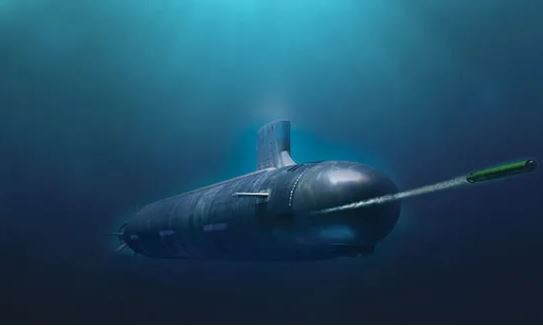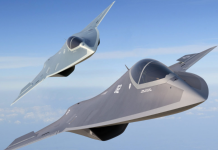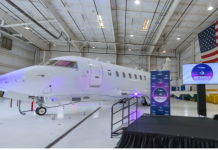Quietly and secretly patrolling strategically vital areas of the undersea, nuclear-armed submarines makeup as much as 70 percent of the US nuclear arsenal, as they ensure the complete annihilation of any nation or actor willing to attack the US with nuclear weapons.
The ability to ensure a catastrophic, crippling retaliatory nuclear strike in the event of a nuclear attack is intended to generate what could be called a paradoxical mission scope, as they are tasked with maintaining an ability to guarantee complete destruction, for the purpose of keeping the peace.
Columbia-Class Submarines
This concept of strategic deterrence is the reason why the Pentagon explains its now emerging Columbia-class submarines are the number 1 acquisition priority across the DoD. Given this, it is no surprise that a keel-laying ceremony for the first Columbia-class submarine, to be called the USS District of Columbia, was heavily attended and celebrated by all ranks within the Navy and broader collection of military services.
As a replacement for the aging Ohio-class submarines, the new Columbia-class boats are slated to serve well into the 2080s and beyond, a Naval Sea Systems Command report on the Keel laying ceremony stated.
At a length of 560 feet and displacing 20,810 tons, the Columbia will be the largest submarine ever built by the U.S. Its reactor will not require refueling during the lifetime of planned service making the ship more cost-effective to operate and maximizing its time in deployment, the Navy report said.
“Potential adversaries know the silent service is on patrol at this very moment, but they don’t know where and that protects us all,” Navy Secretary Carlos Del Toro said, according to the just released Naval Sea Systems Command report. “The venerable Ohio-class that has guarded us for decades is nearing the end of its service life. For the safety of our Sailors, and the security of our world, we must modernize our fleet, and our nuclear command, control, and communications systems.”
Adm. Daryl Caudle, commander, U.S. Fleet Forces Command, said the SSBN nuclear-armed submarines are the most “survivable” leg of the undersea triad, suggesting they were indeed much less vulnerable to enemy attack. The reason for this is clear .. they conduct clandestine missions and adversaries simply have no idea where they are. However, adversaries are assured that they will be completely destroyed in the event they choose to use nuclear weapons against the US.
As for survivability, Caudle seems to have a point. Certainly nuclear-armed aircraft such as a not-so-stealthy B-52 might be both detectable and vulnerable to enemy air defenses. Stealthy nuclear-capable aircraft such as the B-2, B-21 or F-35A might fare better yet they would require some measure of air superiority to deliver nuclear weapons on target from above.
Silos for ground-based ICBMs might be seen by an adversary over satellites and therefore be easier to target. Nuclear armed Columbia class submarines, engineered with paradigm-changing “quieting” technologies, an electric drive, Mk 48 torpedoes and both low and high yield Trident II D5, circumstances which unquestionably enhance its survivability. The range of the Trident II D5s means Columbia-class submarines can hold the entire world at risk at any given time, thus greatly reinforcing the US strategic deterrence posture.
The delivery of the first Columbia-class boat, called the USS District of Columbia, is slated for 2027. Also, the Navy plans to build only 12 Columbia-class boats, as opposed to the current fleet of 14 Ohio-class submarines, because the new submarines have a “life-of-core” nuclear reactor and do not need to return to port for a lengthy period of time for mid-life refueling. For this reason, deployments will be more sustainable and steady
As the first-in-class SSBN or “Columbia-class” nuclear armed ballistic missile submarine surges forward with keel laying and additional production, the high-priority platforms are tasked with ensuring the survival of the US and its allied partners by ensuring catastrophic retaliation in the event of a nuclear attack.
Due to its critical role in the realm of strategic deterrence, the Columbia-class is perhaps best known for its upgraded Trident II D5 nuclear missiles, weapons which have been upgraded and “extended” through a new Life Extension Variant, bringing the possibility of multiple re-entry vehicles and also now include a more recently introduced low-yield variant.
Mk 48 Torpedoes
However, the Columbia class submarines are not only armed with nuclear weapons but will also carry new, upgraded variants of the Navy’s Mk 48 ADCAP, the advanced capability torpedo, according to a just published Naval Sea Systems Command report on the keel laying of the boat, which will be called the USS District of Columbia.
“The Mk 48 ADCAP torpedo is a heavyweight acoustic-homing torpedo with sophisticated sonar, all-digital guidance and control systems, digital fusing systems and propulsion improvements,” a Naval Sea Systems Command spokesman, told Warrior Maven as far back as 2018.
Many of these innovations built into the Mk 48 ADCAP, underway for several years, are now more fully coming to fruition as the first Columbia-class boat comes to life over just the next few years. Delivery of the first boat, now named the US District of Columbia, is slated for 2027. Its first patrol is scheduled for 2031.
Naturally, having a functional and more high-tech lethal torpedo affords the Navy an opportunity to hit enemies more effectively and at further standoff ranges and therefore better compete with more fully emerging undersea rivals such as Russia and China. The Mk 48 heavyweight torpedo is used by all classes of U.S. Navy submarines as their anti-submarine warfare and anti-surface warfare weapon, including the Virginia class and the future Columbia class.
A Mk 48 torpedo is 21 inches in diameter and weighs 3,520 pounds; it can destroy targets at ranges out to five miles and travels at speeds greater than 28 knots. The weapon can operate at depths greater than 1,200 feet and fires a 650-pound high-explosive warhead, available Navy and Lockheed data states.
Navy efforts to pursue new torpedo technologies are happening alongside a concurrent effort to upgrade the existing arsenal.For several years now, the Navy has been strengthening its developmental emphasis upon the Mk 48 as a way to address its aging arsenal. The service restarted production of the Mk 48 torpedo mod 7 in 2016
The Navy’s upgraded Mod 7 Mk 48 torpedo variant will arm the Columbia-class nuclear armed ballistic missile submarines with a longer-range, more lethal and more capable conventional weapon. While lesser recognized than the Columbia’s nuclear weapons, the Mk 48 adds substantial new dimensions to the boat’s lethality and mission scope.
The first Columbia-class submarine, now named the USS District of Columbia, will be armed with Mk 48 torpedoes, according to a recently published Naval Sea Systems Command report.
At the same time, the upgraded Mk 48 weapon is also introducing paradigm-changing “quieting” technologies to help ensure the highly secretive Columbia-class submarines task with ensuring the survival of the US, remain undetected. In effect, it would be accurate to say that the upgraded variant of the Navy’s Mk 48 Torpedo has some stealthy characteristics.
An earlier version, the Mk 48 Mod 6, has been operational since 1997 – and the more recent Mod 7 has been in service since 2006. Since that time, Lockheed Martin has been working on upgrades to the Mk 48 torpedo Mod 6 and Mod 7 – which consist of adjustments to the guidance control box, broadband sonar acoustic receiver and amplifier components.
“The latest version of the Mk 48 ADCAP (advanced capability) is the mod 7 Common Broadband Advanced Sonar System. The Mk 48 ADCAP mod 7 CBASS torpedo is the result of a Joint Development Program with the Royal Australian Navy and achieved initial operational capability in 2006,” a spokesman with Naval Sea Systems Command told Warrior several years ago during an earlier phase of its development.
With Common Broadband Advanced Sonar System, or CBASS – electronics to go into the nose of the weapon as part of the guidance section, Lockheed and Navy developers explained.
CBASS technology provides streamlined targeting, quieter propulsion technologies and an ability to operate with improved effectiveness in both shallow and deep water. Also, the Mod 7 decreases vulnerability to enemy countermeasures and allows the torpedo to transmit and receive over a wider frequency band, Lockheed and Navy developers say.
The new technology also involves adjustments to the electronic circuitry to allow the torpedo to better operate in its undersea environment.
Modifications to the weapon have improved the acoustic receiver, replaced the guidance-and-control hardware with updated technology, increased memory, and improved processor throughput to handle the expanded software demands required to improve torpedo performance against evolving threats, according to Navy data on the weapon.
Improved propulsion, quieting technology, targeting systems and range enhancements naturally bring a substantial tactical advantage to Navy undersea combat operations. Attack submarines are often able to operate closer to enemy targets and coastline undetected, reaching areas typically inaccessible to deeper draft surface ships.
Such an improvement would also, quite possibly, enable attack submarines to better support littoral surface platforms such as cruisers, destroyers and even carriers. Working in tandem with surface-ship anti-submarine and surface warfare systems, attack submarines with a more capable torpedo could better identify and attack enemy targets near coastal areas and shallow water enemy locations.
Avoiding detection is of course critical for the SSBNs, which is one reason why the Navy’s new Columbia-class submarines are expected to be the quietest ever built, as they are engineered with an X-shaped stern for quieter, less turbulent maneuverability, an quieter electric-drive propulsion system and even quieting technologies built into its Mk 48 heavyweight torpedoes. These innovations are extremely critical, as ensuring that the location of secret Columbia-class submarines remains unknown to enemies is essential to the survival of the United States.
This is also one reason why the nuclear-capable boat is also armed with heavyweight torpedoes with advanced datalinks and targeting technology to ensure the boat can eliminate threats and defend itself against an attack. A Military Analysis Network report from the Federation of American Scientists further specifies that the torpedo uses a conventional, high-explosive warhead.
“The MK 48 is propelled by a piston engine with twin, contra-rotating propellers in a pump jet or shrouded configuration. The engine uses a liquid monopropellant fuel,” the FAS analysis states.
Submarine operators are able to initially guide the torpedo toward its target as it leaves the launch tube, using a thin wire designed to establish an electronic link between the submarine and torpedo, the information says.
“This helps the torpedo avoid decoys and jamming devices that might be deployed by the target. The wire is severed and the torpedo’s high-powered active/passive sonar guides the torpedo during the final attack,” FAS writes.
In 2018, Lockheed Martin Sippican was awarded a new deal to work on guidance and control technology on the front end of the torpedo, and SAIC was awarded the contract for the afterbody and propulsion section, Naval Sea Systems Command officials announced at the time.
The Mk 48, which is a heavy weapon launched under the surface, is quite different from surface launched, lightweight Mk 54 torpedoes fired from helicopters, aircraft and surface ships. The upgraded Mk 48 variant is more lethal and has now been upgraded to include improved propulsion, explosives, electronics and quieting technologies.
The Navy’s Mk 48 torpedo is also in service with Australia, Canada, Brazil and The Netherlands.





